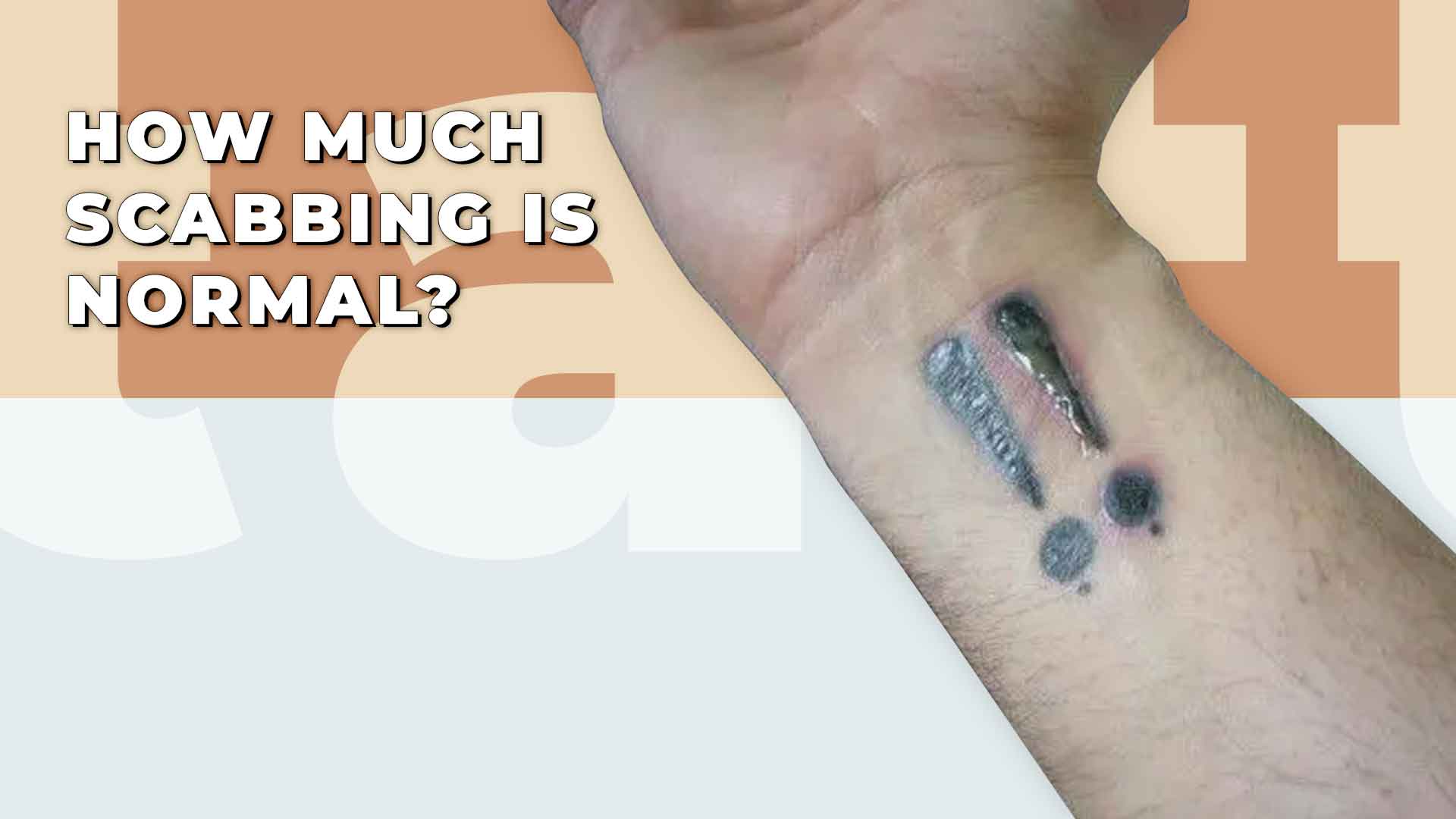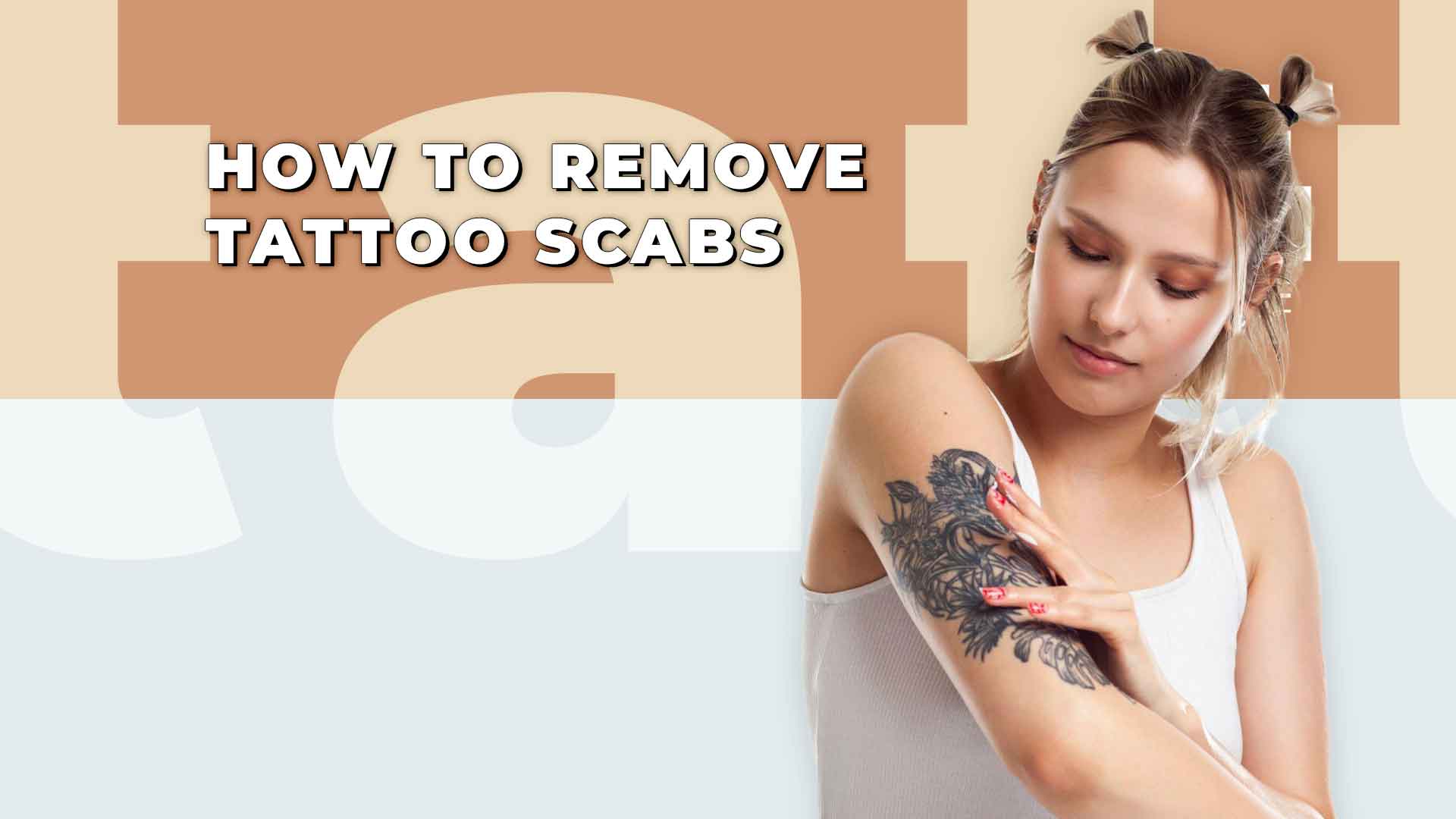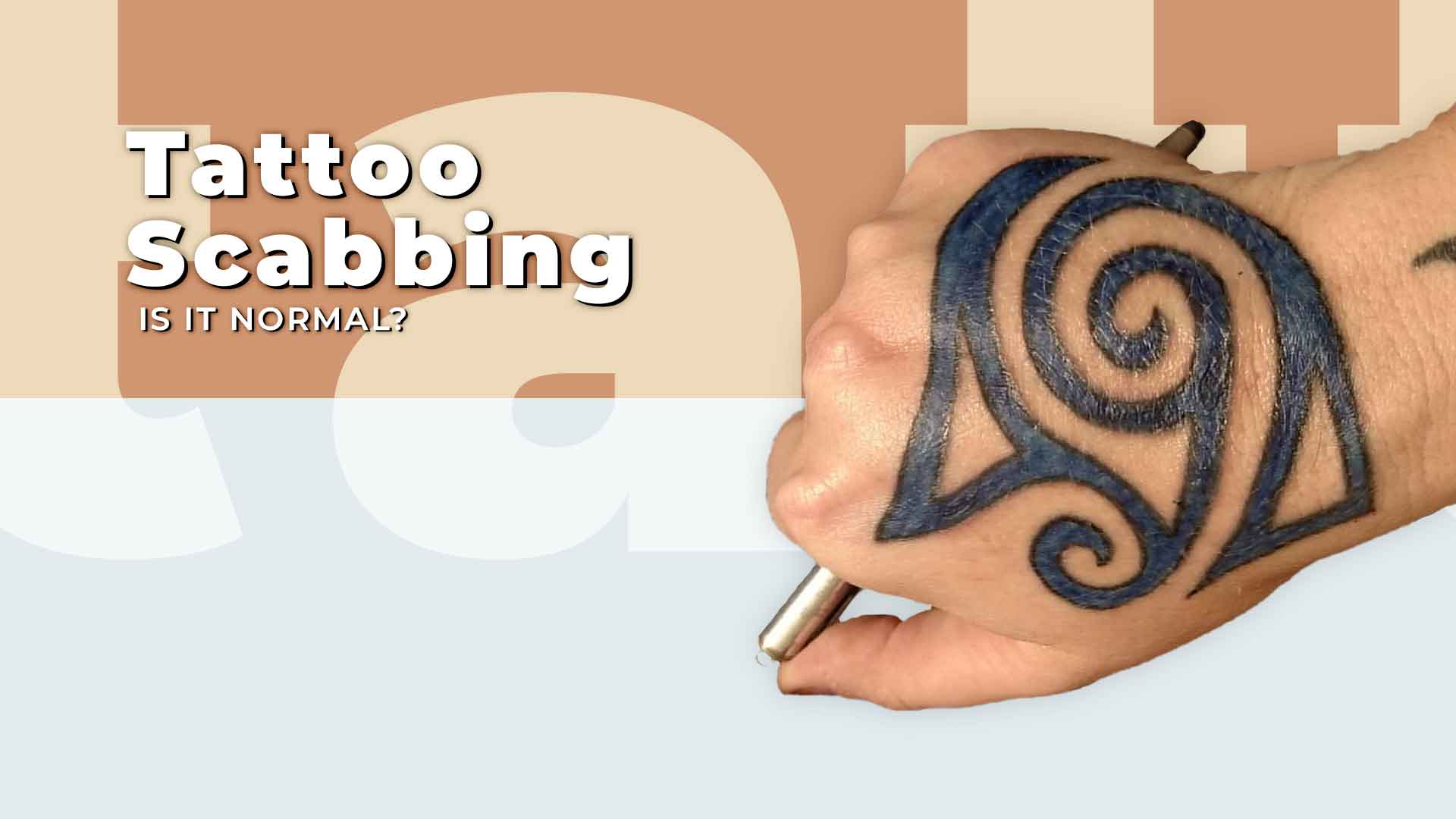You found a great tattoo artist and had an amazing session to turn your skin into art. Following your artist’s precise aftercare instructions, everything seems to be progressing seamlessly. Yet, amidst this, you notice a minor concern gnawing at your thoughts – a scab has made its appearance on your exquisite tattoo! Is this normal in the tattoo healing process, or should it set off alarm bells?
The presence of light to moderate tattoo scabbing is a natural part of the healing journey. However, if you encounter extensive scabbing that is accompanied by discomfort and an uneven, raised texture, it is a cause for concern.
This article focuses on the second stage, “Scabbing and Peeling,” and explores why it occurs and how to manage it effectively.
My Tattoo is Scabbing: Is it Normal?
Yes, experiencing scabbing on a fresh tattoo is a common occurrence and, in most cases, entirely normal. Tattoo scabbing is an essential part of the healing process. It indicates that your body is actively engaged in repairing the freshly inked skin. It serves as a protective mechanism, safeguarding the tattooed area during its vulnerable phase.
Several factors can influence the extent and severity of scabbing:
- Skin Type: Different skin types react differently to the tattooing process. Individuals with dry or sensitive skin may experience more pronounced scabbing.
- Tattoo Size and Complexity: Larger and more intricate tattoos tend to produce more scabbing as the body works to heal the increased surface area.
- Tattoo Depth: The depth at which the tattoo needle penetrates the skin can impact scabbing. Deeper tattoos may generate thicker scabs.
- Tattoo Aftercare: Proper aftercare plays a significant role. Failure to follow recommended aftercare instructions can lead to excessive scabbing and potential complications.
Read More: Tattoo Aftercare For Sensitive Skin
Why Does Tattoo Scabbing Happen?
Tattoo scabbing is a natural part of the healing process and occurs for several reasons:
- Skin Trauma: Tattooing involves puncturing the skin with a needle repeatedly. When the body is injured, it naturally protects itself by forming blood clots and scabs. This helps to heal the wound.
- Excess Ink and Fluid: During the tattooing process, excess ink and bodily fluids are often pushed to the surface of the skin. As the skin heals, these substances can mix and harden, forming scabs over the tattooed area.
- Skin Regeneration: Scabbing is a sign that your body is actively working to repair the damaged skin. The formation of scabs is part of the skin’s regeneration process.
How Much Scabbing is Normal?
The amount of scabbing you experience can vary depending on several factors. They include the size and complexity of your tattoo, your skin type, and how well you follow aftercare instructions. In general, it’s normal to see some scabbing, but it should not be excessive or cover the entire tattoo. Small, thin scabs are typically considered normal and are a sign that your body is healing appropriately.
How Long Does Tattoo Scabbing Last?

The duration of tattoo scabbing can also vary from person to person and depends on the factors mentioned above. Typically, scabbing starts around 2 to 3 days after getting the tattoo and can last for about a week or more. However, remember that healing times can be different for everyone. Some people may experience shorter or longer periods of scabbing.
Signs of Abnormal Tattoo Scabbing

While some scabbing is normal during the tattoo healing process, there are certain signs that may indicate abnormal scabbing and require attention. Be on the lookout for the following signs:
- Excessive Scabbing
If your tattoo is covered in thick, large scabs that seem disproportionate to the size of the tattoo, it may be a sign of an issue. - Prolonged Scabbing
If your scabs persist for an extended period, well beyond what is considered typical for healing, it could indicate a problem. - Severe Itching and Discomfort
While some itching is normal, severe and persistent itching may signal an issue. - Unusual Color Changes
If the scabs or the skin underneath them show signs of infection, such as increased redness, warmth, or the presence of pus, seek medical attention promptly. - Bleeding or Oozing
If your tattoo continues to bleed or ooze fluids beyond the initial post-tattoo phase, it may be a cause for concern.
If you notice any of these signs, consult your tattoo artist or a medical professional for evaluation and guidance.
What Happens if You Pick a Tattoo Scab?
Picking at tattoo scabs is strongly discouraged. Doing so can lead to various issues
It can result in the removal of ink along with the scab, leading to patchy or faded areas in the tattoo. Aggressively picking at scabs can also cause scarring. This may alter the appearance of your tattoo permanently.
Opening scabs can introduce bacteria and increase the risk of infection.
How to Remove Tattoo Scabs

Tattoo scabs will naturally shed as part of the healing process. Attempting to forcefully remove them can result in complications.
Scabs will typically begin to loosen and fall off on their own. This process can take several days to a couple of weeks, depending on your body’s healing speed and the tattoo’s size.
If you notice that a scab is ready to come off, you can gently aid the process by applying a warm, damp cloth to soften the scab. Once it’s softened, use a gentle, upward motion to encourage it to come off naturally.
For fresh tattoos, it’s best not to intervene in scab removal. Allow the healing process to run its course.
Can You Tattoo Over Scabs?
No, attempting to tattoo over scabs or unhealed skin is not advisable. Tattooing over scabs can result in uneven ink distribution. It could potentially compromise the tattoo’s quality. Wait until the skin has fully healed and the scabs have fallen off before considering any touch-ups or additional work on the tattoo.
How to Manage Tattoo Scabbing

While tattoo scabbing is a natural part of the healing process, it’s essential to manage it properly to ensure the best possible outcome for your tattoo. Here are some steps to follow during the scabbing and peeling phase:
- Keep it Clean: Proper hygiene is crucial during the healing process. Gently wash the tattooed area with mild, fragrance-free soap and lukewarm water. Avoid using harsh or scented soaps, as they can irritate the healing skin.
- Pat Dry: After washing, gently pat the tattooed area dry with a clean, soft paper towel or cloth. Avoid rubbing, as this can disrupt the scabs and potentially pull out the ink.
- Moisturize: Apply a thin layer of tattoo-specific ointment or moisturizer recommended by your tattoo artist. Keep the tattooed area hydrated to prevent excessive dryness and itching. Using too much moisturizer can be just as bad as using too little, so make sure to follow your artist’s instructions on how often to apply ointment.
- Avoid Picking or Scratching: This cannot be stressed enough. Picking at scabs or scratching the healing tattoo can result in ink loss, scarring, and infection. If the itching becomes unbearable, gently tap or pat the area instead of scratching.
- Avoid Sun Exposure: Direct sunlight can be harmful to a healing tattoo. UV rays can fade the ink and irritate the healing skin, so it’s essential to keep the tattooed area covered or use a high-SPF sunscreen if you must be in the sun.
- Wear Loose Clothing: Tight clothing can rub against the healing tattoo. This can cause irritation and potentially damage the scabs. Opt for loose, breathable clothing during the healing process.
- Stay Hydrated: Drinking plenty of water can help your skin heal more effectively. Proper hydration supports overall skin health and regeneration.
- Monitor for Infection: While it’s relatively rare, infections can occur during the healing process. Watch for signs of infection, such as excessive redness, pus, or increased pain, and consult a medical professional if you suspect an issue.
Tattoo Scabbing vs. Tattoo Rejection
It is important to tell apart tattoo scabbing from tattoo rejection since they are different. Tattoo scabbing is normal during healing, while tattoo rejection is rare. Tattoo rejection occurs when the body’s immune system recognizes tattoo ink as a foreign substance and attempts to remove it. This can result in the tattoo fading or even disappearing over time.
Signs of tattoo rejection may include:
- Persistent redness and inflammation
Beyond the normal healing phase, if your tattoo remains excessively red and inflamed for an extended period, it could be a sign of rejection. - Raised or raised areas
Tattoo rejection can cause the tattooed area to become raised or bumpy. It is not a typical part of the healing process. - Itching and discomfort
While some itching is normal during healing, persistent and severe itching could indicate a problem. - Fading or distortion
If you notice your tattoo’s colors fading significantly or the lines becoming distorted, it may be a sign of tattoo rejection.
If you suspect tattoo rejection, consult your tattoo artist or a dermatologist for further evaluation and advice.
Final Thoughts
Tattoo scabbing is a natural and essential part of the tattoo healing process. While it may cause some discomfort and concern, remember that it’s a sign of your body actively working to heal and protect your new tattoo. To make sure your tattoo heals well and lasts a long time, follow these steps: take care of it, keep it clean, and don’t pick or scratch it. Each person heals differently, so be patient and listen to your body as your tattoo scabs and peels.

